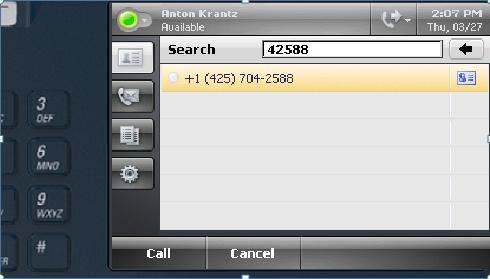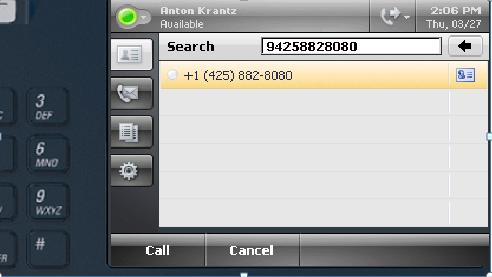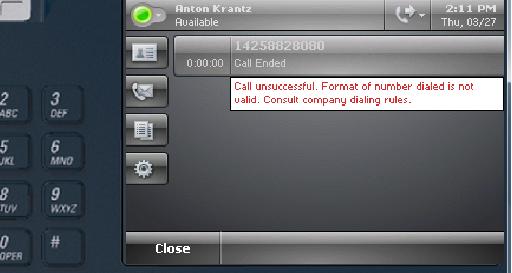Dialing behavior using Microsoft Office Communicator 2007 Phone Edition
Following from Noor’s post on Phone numbers in Microsoft Office Communicator 2007, the subject of this week’s post is the dialing experience on IP phones (e.g. Polycom CX-700 and LG-Nortel IP 8540) running Office Communicator Phone Edition.
Communicator Phone Edition supports name-based dialing: calling contacts directly from the contact list, by searching your Outlook contacts or by searching your corporate directory. However there are still many cases when you need to call someone who is not a contact and it is necessary to dial a phone number.
Communicator Phone Edition enables 2 ways of dialing a number using the dial pad:
- Off-hook dialing. You lift the handset or press the speakerphone button, hear the dial tone and start entering digits. This is the most common way of making calls with fixed-line phones (e.g. your office desk phone or non-cordless home phone). Note that Office Communicator does not currently support off-hook dialing.
- On-hook dialing (sometimes called Pre-dialing). You enter digits using the dial pad and press Call or lift the handset or press the speakerphone button to initiate the call. Phones which do not have a hook switch, such as cell phones or wireless home phones, use this method. The more advanced fixed-line phones also support on-hook dialing. Note that Office Communicator currently supports only on-hook dialing.
The dialing is experience is determined by a set of dialing rules which are configured by the Office Communications Server (OCS) administrator. Communicator Phone Edition downloads these when it connects to the server. The dialing rules determine how Communicator Phone Edition interprets the digits entered by the user to form a routable phone number in a process called normalization. You’ll know a number has been normalized correctly when you see it in the Communicator Phone Edition UI.
In the above example, I dialed an internal company extension by entering the digits 42588. The dialing rules normalized the number to +14257042588 using the E.164 international standard for phone numbers. You see it in the UI as +1 (425) 704-2588 as the dialing rules contain beautifiers which are used to format the number for display purposes only.
What are the issues with off-hook dialing?
Because there are some differences in the way off-hook and on-hook dialing work, this can cause inconsistencies in the dialing behavior. When dialing off-hook, as soon as you enter numbers matching a dialing rule, the phone places a call. In the above example, if I actually went off-hook and intended to dial a 10-digit external number such as (425) 882-8080, the call would be placed prematurely to the “wrong” number. This is because there is an overlap between the 10-digit external number and the 5-digit internal extension. Legacy PBX (private branch exchange) systems used by most companies have the same issue and require users to dial an external access prefix (typically 9 in the US and 0 in Europe) to get an outside line.
In the off hook case, without dialing the external access prefix, it would not be possible to distinguish between dialing an internal extension and a local area phone number since the dialing rules are being matched on a digit-by-digit basis,. The phone will dial the number corresponding to the first dialing rule which can be matched (the 5-digit extension) even if the caller intended to dial the 10-digit number. This is commonly reported by users as “I was trying to dial a phone number but it stopped dialing prematurely and called some internal extension”.
To enable the off hook dialing experience the same way it is done on PBX systems, the OCS admin can configure a dialing rule which includes the external access prefix. If you wanted to dial the 10-digit number, you would dial 94258828080, you would see it normalized (with beautifiers) as +1 (425) 882-8080 and the call would be placed as soon as you entered the second “0”.
Why doesn’t this happen when I dial on-hook?
The external access problem does not occur in the on hook case since you are explicitly entering the dialed digits before initiating the call. It’s possible to determine exactly what you meant when you entered 42588 or 4258828080. This is where the difference in behavior between off hook and on hook dialing becomes apparent. In the off hook case you need to dial 9 to dial a number and in the on hook case you don’t.
How does this affect me?
It might not; it depends on what your OCS administrator has configured. Some administrators and users don’t mind that there is a difference between on-hook and off-hook dialing and some do. Fortunately OCS and Communicator Phone Edition cater to both. For the latter category of deployments, which want to ensure consistency between off hook and on hook dialing, the dial plan allows the administrator to configure rules which should not be dialed in the on hook case since they would overlap with other rules. The 10-digit number without the external access prefix above is one example. Users dialing a number matching this rule will see a message indicating that dialing rules prevent it from being dialed. This indicates that although the dial string is otherwise valid, the administrator has provisioned a rule preventing it from being dialed.
In the example below, a long distance number preceded by a 1 (14258828080) will overlap with a 5-digit extension (14258). The admin for this company has chosen to provision the rule to prevent the overlap.
We hope this explains the dialing behavior for existing TDM phones and Communicator Phone Edition and some of the history behind it. As always, we welcome your feedback on our blog posts. Please feel free to share comments in the Comments section of this blog.
Anton Krantz
Senior Program Manager
Published Friday, March 28, 2008 1:34 PM by octeam
Filed Under: Devices


